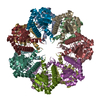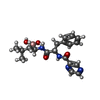+ Open data
Open data
- Basic information
Basic information
| Entry | Database: PDB / ID: 9dkw | ||||||
|---|---|---|---|---|---|---|---|
| Title | Human mitochondrial ClpP in complex with Bortezomib | ||||||
 Components Components | ATP-dependent Clp protease proteolytic subunit, mitochondrial | ||||||
 Keywords Keywords | HYDROLASE / Protease / Proteolysis | ||||||
| Function / homology |  Function and homology information Function and homology informationmembrane protein proteolysis / mitochondrial protein catabolic process / endopeptidase Clp / endopeptidase Clp complex / ATP-dependent peptidase activity / protein quality control for misfolded or incompletely synthesized proteins / Mitochondrial protein degradation / proteolysis involved in protein catabolic process / peptidase activity / ATPase binding ...membrane protein proteolysis / mitochondrial protein catabolic process / endopeptidase Clp / endopeptidase Clp complex / ATP-dependent peptidase activity / protein quality control for misfolded or incompletely synthesized proteins / Mitochondrial protein degradation / proteolysis involved in protein catabolic process / peptidase activity / ATPase binding / endopeptidase activity / mitochondrial matrix / serine-type endopeptidase activity / mitochondrion / proteolysis / identical protein binding Similarity search - Function | ||||||
| Biological species |  Homo sapiens (human) Homo sapiens (human) | ||||||
| Method | ELECTRON MICROSCOPY / single particle reconstruction / cryo EM / Resolution: 2.49 Å | ||||||
 Authors Authors | Uday, A.B. / Zeytuni, N. / Goncalves, M. / Vahidi, S. | ||||||
| Funding support |  Canada, 1items Canada, 1items
| ||||||
 Citation Citation |  Journal: Proc Natl Acad Sci U S A / Year: 2025 Journal: Proc Natl Acad Sci U S A / Year: 2025Title: Mechanism of allosteric activation in human mitochondrial ClpP protease. Authors: Monica M Goncalves / Adwaith B Uday / Taylor J B Forrester / S Quinn W Currie / Angelina S Kim / Yue Feng / Yulia Jitkova / Algirdas Velyvis / Robert W Harkness / Matthew S Kimber / Aaron D ...Authors: Monica M Goncalves / Adwaith B Uday / Taylor J B Forrester / S Quinn W Currie / Angelina S Kim / Yue Feng / Yulia Jitkova / Algirdas Velyvis / Robert W Harkness / Matthew S Kimber / Aaron D Schimmer / Natalie Zeytuni / Siavash Vahidi /  Abstract: Human ClpP protease contributes to mitochondrial protein quality control by degrading misfolded proteins. ClpP is overexpressed in cancers such as acute myeloid leukemia (AML), where its inhibition ...Human ClpP protease contributes to mitochondrial protein quality control by degrading misfolded proteins. ClpP is overexpressed in cancers such as acute myeloid leukemia (AML), where its inhibition leads to the accumulation of damaged respiratory chain subunits and cell death. Conversely, hyperactivating ClpP with small-molecule activators, such as the recently discovered ONC201, disrupts mitochondrial protein degradation and impairs respiration in cancer cells. Despite its critical role in human health, the mechanism underlying the structural and functional properties of human ClpP remains elusive. Notably, human ClpP is paradoxically activated by active-site inhibitors. All available structures of human ClpP published to date are in the inactive compact or compressed states, surprisingly even when ClpP is bound to an activator molecule such as ONC201. Here, we present structures of human mitochondrial ClpP in the active extended state, including a pair of structures where ClpP is bound to an active-site inhibitor. We demonstrate that amino acid substitutions in the handle region (A192E and E196R) recreate a conserved salt bridge found in bacterial ClpP, stabilizing the extended active state and significantly enhancing ClpP activity. We elucidate the ClpP activation mechanism, highlighting a hormetic effect where substoichiometric inhibitor binding triggers an allosteric transition that drives ClpP into its active extended state. Our findings link the conformational dynamics of ClpP to its catalytic function and provide high-resolution structures for the rational design of potent and specific ClpP inhibitors, with implications for targeting AML and other disorders with ClpP involvement. | ||||||
| History |
|
- Structure visualization
Structure visualization
| Structure viewer | Molecule:  Molmil Molmil Jmol/JSmol Jmol/JSmol |
|---|
- Downloads & links
Downloads & links
- Download
Download
| PDBx/mmCIF format |  9dkw.cif.gz 9dkw.cif.gz | 612.8 KB | Display |  PDBx/mmCIF format PDBx/mmCIF format |
|---|---|---|---|---|
| PDB format |  pdb9dkw.ent.gz pdb9dkw.ent.gz | 406.6 KB | Display |  PDB format PDB format |
| PDBx/mmJSON format |  9dkw.json.gz 9dkw.json.gz | Tree view |  PDBx/mmJSON format PDBx/mmJSON format | |
| Others |  Other downloads Other downloads |
-Validation report
| Arichive directory |  https://data.pdbj.org/pub/pdb/validation_reports/dk/9dkw https://data.pdbj.org/pub/pdb/validation_reports/dk/9dkw ftp://data.pdbj.org/pub/pdb/validation_reports/dk/9dkw ftp://data.pdbj.org/pub/pdb/validation_reports/dk/9dkw | HTTPS FTP |
|---|
-Related structure data
| Related structure data |  46971MC  9dkvC  9dqkC  9dqlC C: citing same article ( M: map data used to model this data |
|---|---|
| Similar structure data | Similarity search - Function & homology  F&H Search F&H Search |
- Links
Links
- Assembly
Assembly
| Deposited unit | 
|
|---|---|
| 1 |
|
- Components
Components
| #1: Protein | Mass: 24179.875 Da / Num. of mol.: 14 Source method: isolated from a genetically manipulated source Source: (gene. exp.)  Homo sapiens (human) / Gene: CLPP / Production host: Homo sapiens (human) / Gene: CLPP / Production host:  #2: Chemical | ChemComp-BO2 / #3: Water | ChemComp-HOH / | Has ligand of interest | Y | Has protein modification | Y | |
|---|
-Experimental details
-Experiment
| Experiment | Method: ELECTRON MICROSCOPY |
|---|---|
| EM experiment | Aggregation state: PARTICLE / 3D reconstruction method: single particle reconstruction |
- Sample preparation
Sample preparation
| Component | Name: Human mitochondrial ClpP in complex with Bortezomib / Type: COMPLEX / Entity ID: #1 / Source: RECOMBINANT | |||||||||||||||||||||||||
|---|---|---|---|---|---|---|---|---|---|---|---|---|---|---|---|---|---|---|---|---|---|---|---|---|---|---|
| Source (natural) | Organism:  Homo sapiens (human) Homo sapiens (human) | |||||||||||||||||||||||||
| Source (recombinant) | Organism:  | |||||||||||||||||||||||||
| Buffer solution | pH: 7.8 | |||||||||||||||||||||||||
| Buffer component |
| |||||||||||||||||||||||||
| Specimen | Conc.: 18 mg/ml / Embedding applied: NO / Shadowing applied: NO / Staining applied: NO / Vitrification applied: YES | |||||||||||||||||||||||||
| Vitrification | Instrument: FEI VITROBOT MARK IV / Cryogen name: ETHANE / Humidity: 100 % / Chamber temperature: 277 K |
- Electron microscopy imaging
Electron microscopy imaging
| Experimental equipment |  Model: Titan Krios / Image courtesy: FEI Company |
|---|---|
| Microscopy | Model: FEI TITAN KRIOS |
| Electron gun | Electron source:  FIELD EMISSION GUN / Accelerating voltage: 300 kV / Illumination mode: FLOOD BEAM FIELD EMISSION GUN / Accelerating voltage: 300 kV / Illumination mode: FLOOD BEAM |
| Electron lens | Mode: BRIGHT FIELD / Nominal defocus max: 2500 nm / Nominal defocus min: 1000 nm |
| Image recording | Electron dose: 60 e/Å2 / Film or detector model: GATAN K3 BIOQUANTUM (6k x 4k) |
- Processing
Processing
| EM software |
| ||||||||||||||||||||||||
|---|---|---|---|---|---|---|---|---|---|---|---|---|---|---|---|---|---|---|---|---|---|---|---|---|---|
| CTF correction | Type: PHASE FLIPPING AND AMPLITUDE CORRECTION | ||||||||||||||||||||||||
| Symmetry | Point symmetry: D7 (2x7 fold dihedral) | ||||||||||||||||||||||||
| 3D reconstruction | Resolution: 2.49 Å / Resolution method: FSC 0.143 CUT-OFF / Num. of particles: 408161 / Symmetry type: POINT | ||||||||||||||||||||||||
| Refinement | Cross valid method: NONE Stereochemistry target values: GeoStd + Monomer Library + CDL v1.2 | ||||||||||||||||||||||||
| Displacement parameters | Biso mean: 26.49 Å2 | ||||||||||||||||||||||||
| Refine LS restraints |
|
 Movie
Movie Controller
Controller




 PDBj
PDBj


